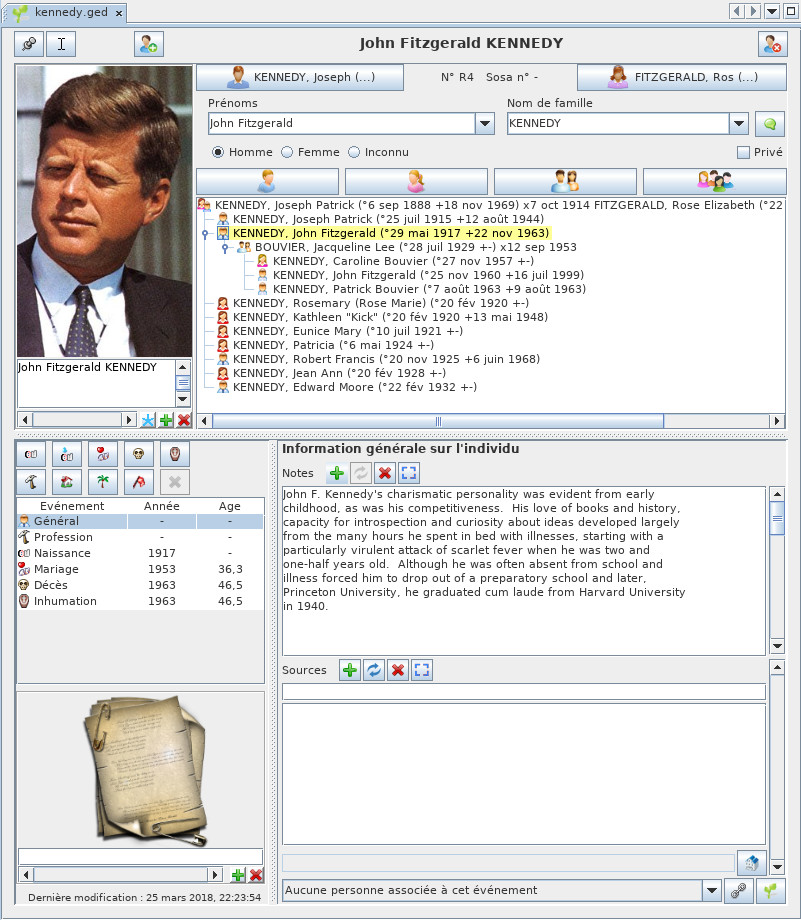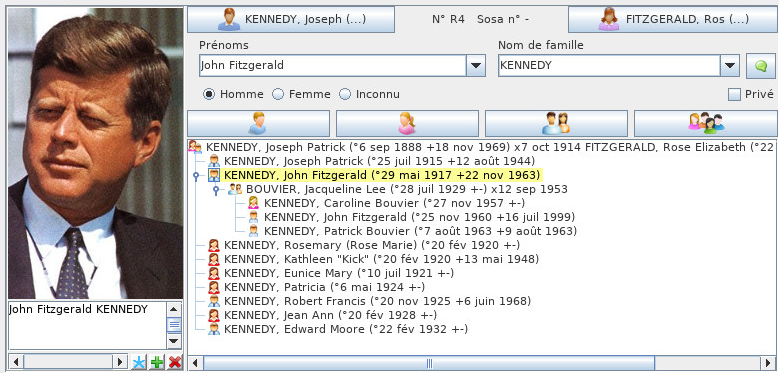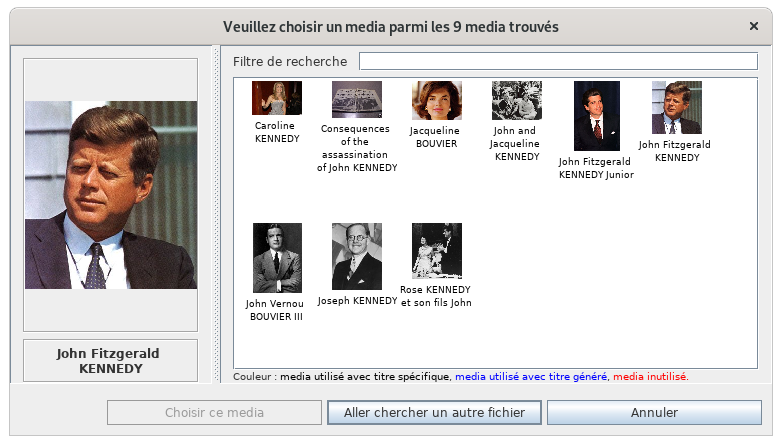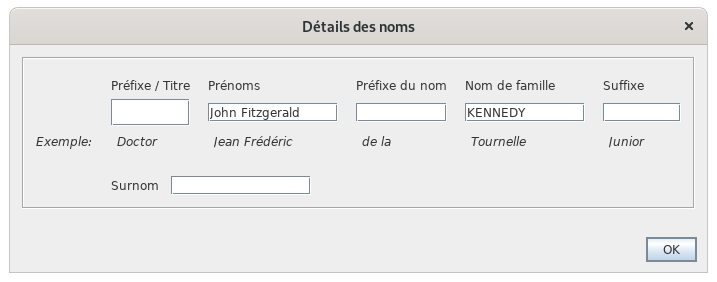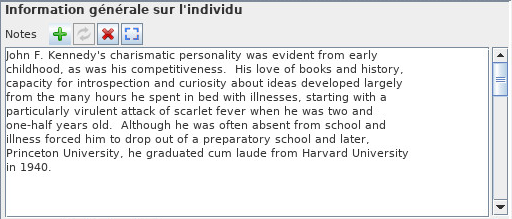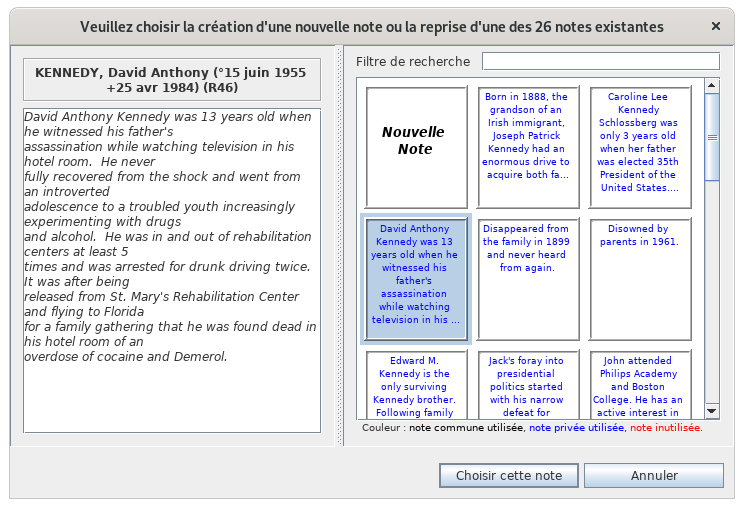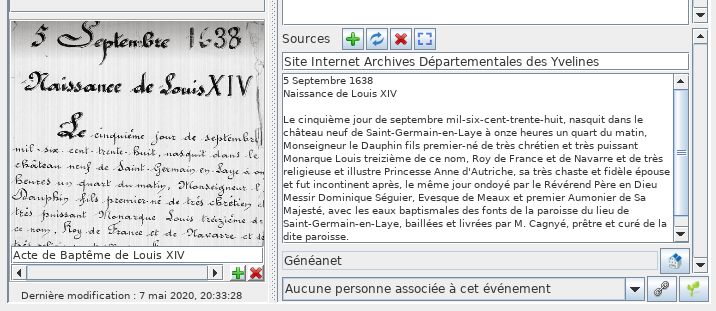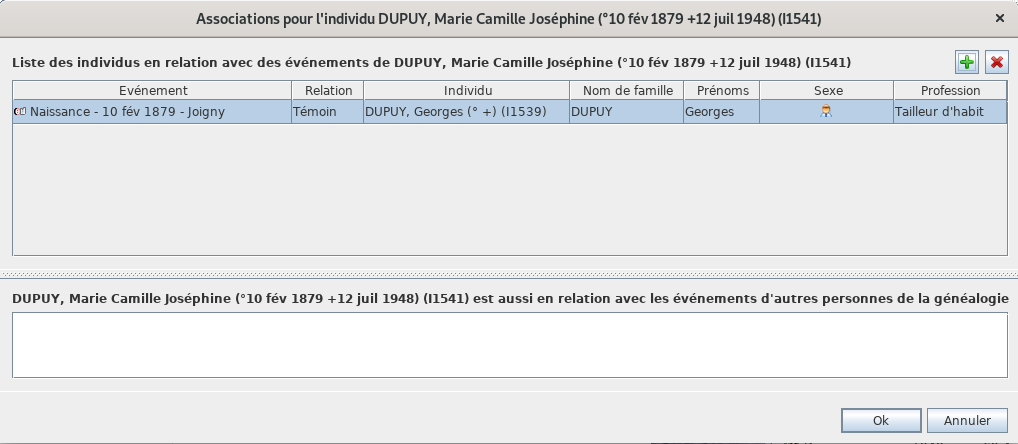Cygnus editor (SL)
The Cygnus editor is one of the three main editors of Ancestris.
The philosophy of the Cygnus editor comes from the desire for simplicity of use.
The simplicity of being able to manipulate individuals and everything around at a glance,
Without worrying about how information is stored behind the scenes,
All other information, families, sources, notes, etc. are ultimately only complementary information relating to the life of the individual in question. Example: shouldn't the seizure of an individual's marriage be done in the same place and in the same way as the seizure of his birth or death? This is what Cygnus can do.
The advantage is to see almost everything at a glance, like a bird watching the earth from the sky.
Did you know that? Its name comes from the large and brilliant constellation of the Swan. With its stars mainly arranged according to a large cross, it is represented as a bird spreading its wings.
Cygnus efficiently does a lot of work for you behind the scenes. Creating a spouse, for example, takes just one click, whereas it requires a lot of action in the other two editors.
The compromise is that only the most important genealogical information can be edited with this editor, but still covers the needs of 80% of users.
There is something for everyone, and Ancestris users often choose to use two main editors: Cygnus + Gedcom, or Aries + Gedcom. Some prefer to use only the Gedcom editor. Here is a comparison of the 3 editors if you still had to make a choice.
| Cygnus | Gedcom | Aries | |
| Focus | The individual and his close environment | The Gedcom standard |
Completeness of |
| Ease of use | ++ | +++ | + |
| Ergonomics | +++ | + | +++ |
| Coverage of needs | 80% | 100% | 100% |
| Data Transparency | + | +++ | ++ |
| Efficiency | +++ | + | + |
| Editable Gedcom entities | Many | All | All |
| Compliance with Gedcom standard | 100% | 100% | 100% |
Description and Usage
Cygnus presents the individual in the upper part of the window with the Title bar, his family nucleus just below, and the details of his life in the lower part, with the associated life events.
Title bar
The title bar displays the name of the selected individual and buttons.
Hovering over the buttons displays a tooltip.
Pin Button
Freezes the editor on this individual even if another entity is selected in Ancestris.
Cursor Button
Keeps the focus on the editor when changing entities.
A mouse selection of an individual in the entity table or in the tree, for example, normally causes the focus on the Cygnus Editor to be lost.
If you want to keep the focus on the editor, this button brings the focus back to the first name of the individual and positions the cursor there.
Create a new individual Button
Creates a new individual and places him/her in the editor.
Delete this individual Button
Deletes the individual displayed with a confirmation request.
Contextual menu
Right-clicking on this title bar displays the contextual menu.
Separation bar
The separation bar shown in yellow below can be moved with the mouse. It allows you to adjust the respective sizes allocated to the family nucleus and life events.
The position of the separation bar is kept from one time to another by genealogy / Gedcom file.
Family nucleus
Above the separation bar is the individual's family nucleus.
Photo frame
This frame displays all the photos and other media (video, soundtrack, etc.) of the individual and his or her life events.
The photos displayed at each moment are those of the event selected in the life events section.
Media included in the sources are not displayed here, but in the Life Events photo frame.
The photo media display the photo. Other media (sounds, videos, documents) display a representative media icon.
A horizontal scroll bar allows you to scroll through the photos of a given event.
You can specify a short description for each photo.
Several actions are possible regarding the displayed media.
- A single left click changes the media, whatever it is
- Right-clicking displays the media in your computer's media viewer.
- If it's a photo, the photo will be displayed in large size in your image viewer.
- If it is a video or soundtrack, it is played in your favorite media player.
- When the media is a photo
- Drag and drop with the mouse to crop the photo
- The thumbwheel allows you to zoom in and out.
- Finally a Ctrl+Click allows to freeze and save the photo cropping
The choice of a photo is made via the media selection window.
The media are displayed on the right side.
The left side displays the selected media.
The media titles have three possible colors.
- In black the media whose title is filled in with the media
- In blue the media whose title is deduced from the entity that uses it
- In red unused media
The Choose this media button associates it with the individual and closes the window.
Description of the individual
This section allows you to specify the name and gender of the individual.
- The First names drop-down menu allows you to select a first name among those already used in genealogy.
- The Surnames drop-down menu allows you to select a surname from those already used in genealogy.
The checkbox  allows to mark this individual as private. For more details on this subject, see the Private data page of the Preferences)
allows to mark this individual as private. For more details on this subject, see the Private data page of the Preferences)
Above the first and last names is indicated the identification number of the individual and his Sosa number when it was generated.
Around this description are arranged 6 buttons Relationships concerning the parents of the individual, his brothers and sisters, his spouse and his children.
These Relationship buttons are multi-function.
- A left click on the button will not have the same result depending on whether the individual in relation already exists or not yet.
- If the individual already exists, it is selected and the editor will navigate to this individual and display it.
- If the individual in relationship does not exist, he is created.
- Right-clicking displays a menu with the choices that seem most relevant to that individual and the relationship in question.
- These choices are arranged in four categories
- Navigation to the individuals concerned, if there are several brothers, sisters, spouse or children
- Creating an individual in genealogy and connecting him/her with others
- Add an individual relationship already existing in genealogy
- Detach the individual relationship
Close Family Tree
This tree structure presents.
- in yellow, the selected individual,
- his parents at the upper level
- his siblings at his level in the order of births
- his or her spouse(s) are listed below
- and the corresponding children at the lower level
A double-click on one of the individuals selects it.
Life events
This part of the Cygnus editor details the events of an individual's life.
A vertical separation bar delimits on the left the list of events and the media of the associated sources, and on the right the details of these events. It can be moved and its position is memorized from one time to another.
Events
List of events
We distinguish the General event from the others.
- It is a particular event that allows you not to define a particular event precisely.
- It allows to associate notes and sources to the individual to characterize the whole of his life, without attaching them to a particular moment of life.
All other events are those that the Gedcom standard allows to define. They are very numerous (birth, marriage, profession, residence, death, burial, etc.).
All events are listed in a single lifeline, including unions. You can therefore create a baptism event and a wedding event in the same place and in the same way.
Indeed, unlike the other two editors, Cygnus being centered on the individual, there is no distinction of capture between the events of the individual entity and the events of the family entities concerning him/her as spouse.
The list displays the default events in chronological order, using date as the event logic (a death occurs after a birth).
The list can be sorted by clicking on the column header, in ascending order with one click, or descending order with a second click.
The width of the columns can be adjusted with the mouse.
Selecting an event displays its details on the right side, and its associated photos in the photo frame at the top of the editor, and source documents in the source media frame at the bottom left of the editor.
Buttons for creating or selecting events
A set of 10 buttons allows you to manage the most common events more efficiently.
- The first 8 from the top are the most common events used in genealogy.
- The first is that of birth. A click on this button creates the birth event if it does not already exist, and selects the birth event otherwise
- The one underneath is that of the profession. As there can be several occupations for the same individual, a click on the button displays a drop-down menu asking if you want to create an occupation or offers you to select one of the existing occupations. When there are none, it creates one.
- The penultimate button is a button that displays all other possible events in a list. It is up to you to choose the one you want to create
- The last button deletes the selected event. The General event cannot be deleted
Details of an event
For each selected event, the right part allows you to fill in the same information, except for the General event which does not need some of it. All this information is provided in the Gedcom standard.
Description of the event
It is a dropdown list to store data already filled in for other events if the description can be reused.
Date and time
See the dates page for more details.
Below the date is displayed the day of the week if it is dated, and the age of the person at the time of the event except for the day of birth.
Place
Notes
It is possible to enter one or more notes, specific or shared. See the difference in the Shared Information section.
Cygnus recognizes, displays and edits specific notes but only creates shared notes.
The mouse wheel is used to scroll through the note text if it requires more lines than there is room to display. The right scrollbar allows you to do the same. It appears when all the lines cannot be displayed.
By pressing the Ctrl key and using the mouse wheel, you can scroll through the notes. The other scrollbar on the right allows you to do the same thing.
Hovering the right scrollbar with the mouse displays the rank of the displayed note in relation to the total number of notes attached to the event.
The creation and modification of a note with the selection window of an existing note.
The right part lists all the known notes of the genealogy. They are of three origins.
- In black, the notes used by genealogy and contained in Note Entities (shared notes)
- In blue, the notes used by genealogy and contained in notes specific to given entities.
- In red, unused notes.
Sources
It is possible to enter one or more sources, specific or shared.
For example, here is a source of the baptismal certificate of Louis XIV.
The information for the sources is as follows:
- The name of the source
- A text that is generally used to present a transcription of the source text. Indeed, it is better to make the effort once to
- decipher a handwritten text that is difficult to read, rather than to do it every time you read it.
- The name of the repository where the source can be found
- Media associated with the same source
Sources work on the same principle as notes in terms of :
The photo frame of the source of an event works on the same principle as the photo frame of the individual.
Clicking on the media displays the source selection window.
The Repository field allows you to choose the repository from which the source is taken with the button on the right.  .
.
This window contains all the information of the repositories already created or that you would like to create when editing the current individual.
Relations
This is where we capture other individuals in relation to an event, such as witnesses at a wedding or the godparents of a baptized person.
The relationship field is actually a drop-down menu list all the relationships currently entered for this event.
It is possible to select one of them and then click on the button  to navigate to the corresponding individual.
to navigate to the corresponding individual.
The button  allows you to manage individuals in relation to the selected event. Clicking on this button brings up the following window.
allows you to manage individuals in relation to the selected event. Clicking on this button brings up the following window.
In the upper part, this window allows you to add, modify or delete relationships.
For each relationship in the list of relationships that appears, it is possible to define the event to which you wish to associate a relationship, the type of relationship (witness, declarer, etc.), the name of the relationship, its sex and profession.
In the lower part, it displays, for information only, the events of other individuals for which the selected individual is himself associated.
Time stamp of last modification of the entity
The last information visible in the Cygnus Editor is the last modification date of the individual.
This date is updated automatically at each update.
SynchronisationSynchronization avecwith lesother autres vues views
NousAs l'avonswe vu,have dansseen, in Ancestris, àat chaqueevery instantmoment unean entitéentity estis sélectionnéeselected pourto êtrebe l'objetthe deobject laof zonethe dework travail.area.
QuandWhen cettethis entitéentity estis unan individu,individual, celui-cithis apparaîtone enappears personneas principalethe dansmain l'éditeurperson Cygnus.in the Cygnus editor.
QuandWhen cettethis entitéentity n'estis pasnot unan individuindividual (unea famille,family, unea note, etc.), l'éditeurthe Cygnus afficheEditor l'individudisplays reliéthe àindividual cetterelated entitéto àthis partirentity duquelfrom cettewhich entitéthis pourraentity êtrecan éditée.be edited.
L'événementThe sélectionnéselected estevent celuiis auquelthe estone rattachéto l'entitéwhich sélectionnéethe dansentity Ancestris.selected in Ancestris is attached.

